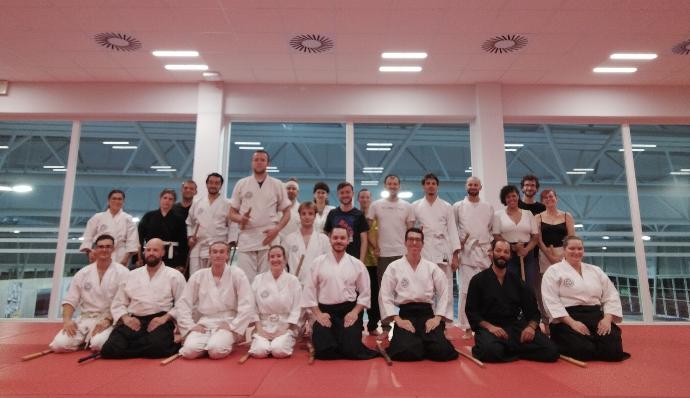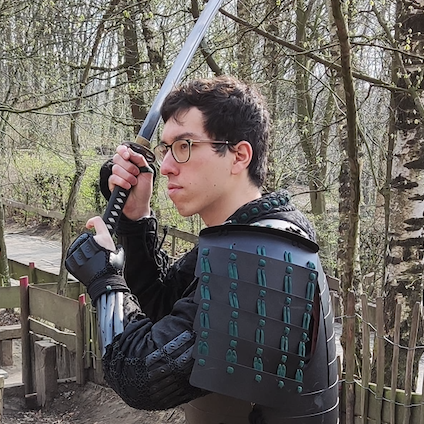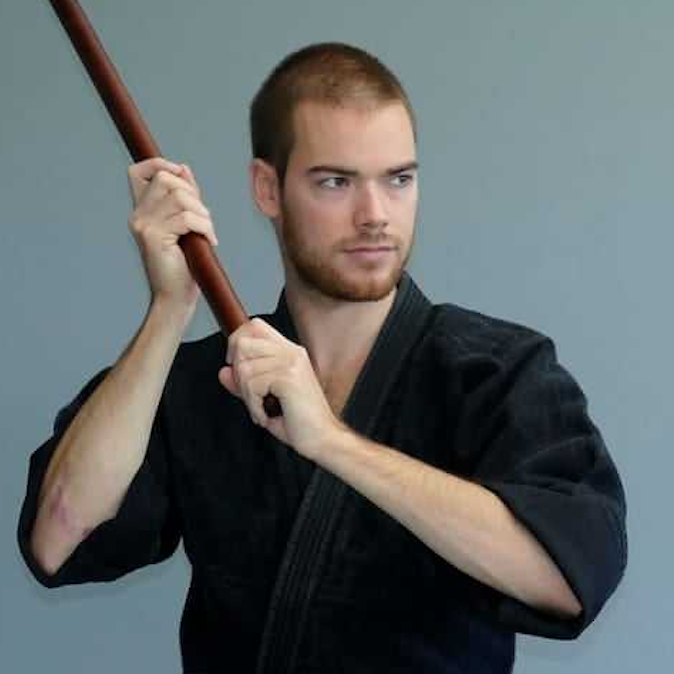About us
Founded in 2018, Mushin no Ryu is a project created on the initiative of three friends who studied martial arts together. Their objective: to continue the transmission of an art that they love, through a dimension of emancipation and elevation. It is as much about the perpetuation of a method as it is about the construction of a lasting group within which the members can flourish thanks to their individuality while strengthening collective emulation.
The Mushin no Ryu team began its training in the years 2007-2009 within the Taiaki dojo and the French AIRBJ (Oudart). For more than five years, they built their theoretical foundations there and were able to develop their educational instincts. There followed a period of three years during which they continued their learning by dissecting each movement, each situation. This work of martial archeology was carried out outside the framework of a dojo, daily, in the open air whatever the circumstances.
The Mushin no Ryu team completed this research with what can be considered a modern-day Musha shugyo. For three years, they traveled across Belgium and France, seeking to compare their understanding of Katori with other disciplines and other trends. This confrontation had to be dissociated from warlike intentions. It was to be conceived as a return from the field, a trial-and-error loop aimed at guiding research and refining the study.
In 2018, satisfied with the path they had taken but aware of the road that remained to be covered, the three friends decided to create a structure conducive to teaching. Indeed, transmitting allows you to confront your certainties while solidifying your understanding. The challenge was to dissect again everything that had been incorporated for three years. Mushin no Ryu was born.
The name comes from two elements: Mushin and Ryu. Mushin represents a state of mind dissociated from a fixation of thought or emotion. It thus allows us to maintain an open mind, free from parasitic elements, quick to encompass the complex. Ryu points to the school. This choice is not trivial. Through our meetings, we received a method in its context and its historical connection. We wish to pass it on, alongside our ability to question an ethereal or dogmatic technique. Mushin no Ryu therefore wishes to promote the incarnation of an art through capacity for action and critical sense.
In 2019, the first dojo opened in Louvain-la-Neuve. It was quickly followed in 2020 by an additional course for UCLouvain students, then in 2022 by a second dojo in Namur. In accordance with the seminal values of the Katori school, everyone is welcome to train regardless of their background. If the partnership with two universities blends wonderfully with its research dynamic, the Mushin no Ryu is happy to count among its members a whole range of backgrounds which blend beautifully. This diversity enriches exchanges on and off the tatami.
In 2023, five members of Mushin no Ryu joined the Belgian delegation invited to present martial arts to the Imperial Court of Japan. Under the leadership of the Japan ASBL, the group presented their work in Katori Shinto Ryu in Kyoto, at the Butokuden. The experience deepened the understanding of the state of martial arts around the world and provided a great perspective for long-term thinking.
The meetings are increasing and each day bring the most interesting discoveries and discussions. We will be delighted to be able to count you among them!
Start of training for senior instructors in Katori Shinto Ryu
Musha shugyo
2018
Creation of Mushin no Ryu
Opening of the first dojo in Louvain-la-Neuve
Opening of an additional course for UCLouvain students
Opening of the second dojo in Namur, in partnership with UNamur
Presentation in Kyoto within the Belgian delegation invited by the Imperial Court of Japan
Years of martial experience
Dojos
Instructors
Members

A method
Our working method consists of articulating the preservation of our traditional technical heritage with the growing need to maintain its real efficiency. Therefore, the need for contextualization seems essential to us in the development of an educational approach which places as much importance on the faithful transmission of knowledge as on the freedom to make it evolve.
From then on, we punctuate the progression of our students around three distinct didactic “times”, the progressive development of which ensures an adaptive and flexible technical evolution, where personification and standardization intertwine around the development of true martial know-how:
1. Omote (表): This first period of learning is also the longest, the most essential and naturally also the most formal. During this critical educational stage, the practitioner is confronted with a demanding technical heritage where repetition and theory are the key words. The teaching of kajo, kamae, but also the values and history of our school takes place during this transfer period.
2. Ura (裏): This second phase aims to sharpen and adapt the formal knowledge previously acquired, allowing the practitioner to recontextualize his technique through a more pragmatic martial logic. However, if this stage grants greater technical flexibility, the emergence of reality also requires a more careful use of the body and previously established knowledge.
3. Bunkai (分解): The final stage of our learning method, this final educational phase focuses on the practitioner's ability to adapt and transform their martial skills in contact with a constantly changing environment. Marked by an acute concern to awaken individual resilience, this last degree marks the supreme objective of our educational process, where the technique requires maximum understanding in order to deliver its full lethal potential.
A group
The group is probably the most important element of a dojo. Certainly because of the working atmosphere, but also because its size and composition depend on the way in which a teaching can be integrated in its entirety.
We are committed to building a group with a family atmosphere promoting exchange and mutual assistance, inside and outside the course. If the instructors play the role of guarantor of transmission, the students are those who become the living memory of the lessons and allow emulation in practice.
Our working method articulates three study periods: omote - ura - bunkai. Within a dojo, it is appropriate to set up a space capable of mobilizing these times. The group therefore becomes, in a way, the channel through which a particular space-time can be contained and explored.
1. If omote (表) is the time of formalization, the group that best corresponds to it is that of all the members of the dojo. Learning the basics must be extended to as many people as possible, at the same time, to ensure the standardization of the process. Using the masses is seen here as a positive way of instilling a common language. It's time to repeat the scales, all together, in the same way.
2. If ura (裏) is the time of recontextualization, the group that best corresponds to it is that of a limited number of dojo members. It is under the structure of a working group that the shared context can be released, ready to confront the formalized technique with the characteristics of reality. The role of instructors is to guide practitioners in understanding a framework, by stimulating feedback. It's time to decipher the score and set the tempo.
3. If bunkai (分解) is the time of adaptation and transformation, the group that best corresponds to it is the individual level. Left to his own devices, the student learns to assimilate the particularities of his body and mind to transcend form and its context. The role of instructors is to offer a soul-to-soul exchange, from one individual to another, by identifying their strengths and weaknesses to help them mature. It's time for composition.
In this paradigm, the group becomes a set of concentric circles evolving simultaneously towards a common objective: the total integration of teaching in a healthy and united atmosphere. The route is long and is easier to navigate if you are well surrounded. In short, our job is to make you hear the music.

The team

François-Guillaume Nihoul
Founder and LLN Instructor
A young 32-year-old philosopher, François-Guillaume Nihoul works as a researcher in the department of management sciences and innovation at the University of Namur where he is pursuing a doctoral thesis.
Sharing his love for space exploration with his passion for martial tradition, François-Guillaume is convinced of the central role played by the contextualization of knowledge, as well as the importance of meaning and technical pragmatism in transmission. In this constant search for truth and perfection, the return to the body therefore seems to him to be a real necessity. Indeed, only the discipline of gesture and its real use seems to be able to definitively free us from the mysticism incurred by the hyper-intellectualization of modern martial arts and their numerous “ritual combats”.

Edouard Xia
Founder and LLN Instructor
A 27-year-old lawyer and political scientist, Edouard Xia works as a researcher in the international relations department of the Catholic University of Louvain where he is pursuing a doctoral thesis.
Dedicated to transmission and a fan of frank sharing on the tatami, Edouard particularly appreciates the exchange of knowledge. His quest for an intimate understanding of art leads him to walk the martial path in search of excellence. From this perspective, discipline and structure seem essential to him in order to correctly approach the subtleties and complexities of handling weapons. In fact, the accuracy and precision of the gesture seem to him to be the guides towards the integration of the great founding principles as well as the technical teachings.

Adrien Manderlier
Founder
A 33-year-old specialist in physical medicine and rehabilitation, Adrien Manderlier practices as a specialist at the Vaud University Hospital Center in Lausanne, Switzerland.
Having started his practice of Katori Shintô Ryu in 2004, he knew a number of teachers before founding Mushin no Ryu with Edouard and François-Guillaume. Convinced that violence has no place in martial arts, he focused his practice on exchange. Kajo practiced in pairs opens up a privileged interpersonal dimension where everyone can express themselves well beyond words. Hard work builds strong bonds and only great trust in his/her partner allows a budoka to express the best of himself. The martial art thus refined and benevolent allows us to go beyond its warlike nature and make it an art of living together.

Arnaud Ilbert
Namur Instructor
A 32-year-old teacher, Arnaud Ilbert works as a French and History teacher in secondary education (5th-6th grade). He is the founder of the Yoroi Sento – Wallonia Bugeikan association, a martial exchange group around the practice of Japanese weapons in armor.
A fan of martial arts for around fifteen years, Arnaud is interested in the study of many forms of fencing. His attraction to the history and material context of the development of martial traditions pushes him to question the origins of the theoretical and technical dogmas of the styles he practices. This historical research guided him towards Katori Shintô Ryu in addition to his practice of other schools of iaido (ZNKR-iaï, Muso Shinden Ryu), kendo and medieval European fencing (13th and 15th centuries). With technical research and martial scholarship at the heart of his practice, he puts experimentation and information sharing at the forefront.